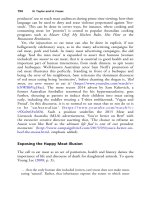The palgrave international handbook of a 485
Bạn đang xem bản rút gọn của tài liệu. Xem và tải ngay bản đầy đủ của tài liệu tại đây (39.59 KB, 1 trang )
Animals in War
487
success with his dogs had less to do with study than with his singular and
natural understanding of the animals. He was convinced that dogs were
sentient, feeling beings able to reason and act with a set of rudimentary morals.
Frankel goes on, ‘Richardson’s breakthrough achievement [ . . . ] was to
place the psychology and morality of the animal at the center of his training
method’ (2014, p. 93).
These ideas are familiar to contemporary animal scholars—the notion that
centering an inquiry upon an animal yields important results; the idea that
animals can reason and act morally. This last point, for instance, is demonstrated and defended by biologist Marc Bekoff and philosopher Jessica Pierce
in their book Wild justice (2009). A thoughtful, sensitive, well-informed
person like Richardson, then, dramatizes the paradox of animals in war.
His gentle training methods and his serious regard for dogs helped win them
a place in the brutal and destructive enterprise of human war. Love, in that
sense, even sincere love, can amount to a kind of abuse.
Human love for dogs can therefore be a heavy burden, a strange form of
harm, something that is also true of the history of horses and other animals in
war. This reality is exemplified by the famous participant in World War II,
Chips. Chips was a mixed-breed dog who was awarded a Purple Heart and Silver
Star, only to have them revoked because it was decided that dogs should not
receive awards intended for people (Lemish 1996, p. 76). Lemish reports that,
by the time the dog’s fame had grown, Chips ‘began to grow weary and skittish
from constant artillery shellfire’ (1996). His notoriety led him to demonstrate
that battle fatigue in a notable event: meeting General Eisenhower. Lemish
writes that when Eisenhower ‘innocently tried to pet him—Chips promptly
nipped the general’s hand’ (1996, p. 76). This should not surprise us today.
Military dog specialists have increasingly recognized that individuals like Chips
can develop post-traumatic stress disorder, much as humans do (Perry 2012;
Alger and Alger 2013, pp. 96–97). Further, when the war had concluded and
Chips was sent back to the U.S., it became clear that the ‘toll of war wore heavily
on the dog’: He survived only a few months before his heart stopped, ‘with his
kidneys already failing’ (Lemish 1996, p. 78).
The story of Chips reiterates some of the problems with designating
animal abuse in war. From one perspective, and in light of what we now
know about his life’s trajectory—increasing war stress that impacted his
behavior, his health, and ultimately his longevity—Chips’s participation in
the war amounts to abuse. However, he is celebrated in texts, and was
celebrated at the time, for his apparently eager, seemingly natural participation in war activities right from the start. One story exists in a number of









